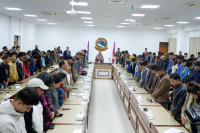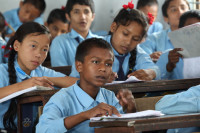Columns
Xi–Trump meeting and the global order
The Xi–Trump encounter symbolises the world’s shift from unipolarity to a contested multipolar order.
Pramod Jaiswal
The recent meeting between Chinese President Xi Jinping and US President Donald Trump has reignited debate over the future of global power transitions. Beyond the symbolic handshake, the encounter represents an attempt to redefine the grammar of great-power engagement at a time of fragmentation, economic uncertainty and deep mistrust. Whether read as reconciliation or recalibration, the dialogue reflects how Washington and Beijing are wrestling to shape the next global order—one that will inevitably affect the Indo-Pacific region and smaller states like Nepal.
Beyond the optics
While much commentary has focused on optics and personal chemistry, the meeting’s underlying message was clear: Confrontation without communication risks global instability. Xi’s call for “mutual respect” and Trump’s rhetorical shift toward “constructive competition” signal a tactical pause rather than a transformation. Discussions reportedly covered trade, technology, Taiwan and the South China Sea, highlighting how security and economics are now inseparable in the US–China relations.
As scholar Jabin T Jacob observes, this rivalry is not simply a tale of one nation’s rise and another’s decline; it mirrors two civilisational powers struggling to define global order. The US, rooted in liberal internationalism, seeks to preserve a system it once built but now finds constrained. China, in contrast, advances a model of authoritarian developmentalism through initiatives such as the Belt and Road Initiative (BRI) and the Asian Infrastructure Investment Bank (AIIB), offering alternatives to Western-led global governance.
New grammar of power
The meeting may mark what analyst Monish Tourangbam calls a “new grammar of great-power relations”—one defined by pragmatic coexistence and strategic ambiguity. Neither side can afford full decoupling: The US depends on Chinese manufacturing and markets, while China needs Western technology and investment. Their dialogue hinted at a conditional détente: Washington recognises the futility of isolating Beijing, while Beijing seeks stability amid domestic economic challenges.
This “managed competition” is reshaping global politics in three ways. First, it affirms a multipolar order, where no single power dominates. Second, it entrenches transactional diplomacy, where short-term interests outweigh normative commitments. Third, it creates strategic fluidity, compelling middle and smaller powers to continuously adjust policies to avoid becoming collateral in great-power rivalries.
American scholar Bonnie S Glaser of the German Marshall Fund notes that US–China relations are “defined by structural rivalry but necessitate engagement when interests converge.” Chinese researcher Wei Nanzhi from the Chinese Academy of Social Sciences argues that “US tariff policies are ineffective,” asserting that China’s long-term policy stability gives smaller nations confidence to maintain engagement with Beijing. Their assessments underscore how both sides acknowledge competition yet seek to avoid uncontrolled escalation.
Reshaping the global order
The Xi–Trump encounter highlights the leadership crisis in global governance. Institutions such as the United Nations and World Trade Organisation are increasingly paralysed by great-power rivalries. The absence of concrete outcomes on climate change, arms control and global finance reveals the erosion of collective problem-solving capacity.
Yet, even a limited thaw between Washington and Beijing could bring stabilising effects. Re-opened communication channels reduce the risk of miscalculation over flashpoints like Taiwan or the South China Sea. Economically, both powers have incentives to prevent major disruptions to global supply chains. A cautious détente might encourage other states to pursue pragmatic multilateralism rather than forced alignment.
Indo-Pacific crossroads
The Xi–Trump dialogue could have two regional effects. First, a temporary easing of tensions may slow militarisation in contested spaces such as the South China Sea, giving ASEAN and South Asian economies breathing space. Second, the uncertainty surrounding Trump’s potential return and his unpredictable policy style injects volatility into regional diplomacy. States like India, Japan, Vietnam and the Philippines must prepare for shifting US commitments while managing China’s deepening footprint.
For South Asia, the implications are twofold: Economically, the US may revive its Indo-Pacific Economic Framework (IPEF) to counter China’s growing investments, while Beijing continues advancing its BRI corridors through Pakistan, Bangladesh and the Himalayas. This dual engagement pushes smaller states to maintain flexible, multidirectional diplomacy.
Nepal’s strategic balancing act
Kathmandu’s long-held policy of “balanced engagement” remains its most valuable strategic asset. A relative easing of US–China tensions could provide Nepal with greater diplomatic space to advance development partnerships without geopolitical penalty.
Economically, reduced friction between the two powers could help stabilise commodity prices, attract investment and encourage multilateral financing—all vital for Nepal’s post-pandemic recovery. Diplomatically, Nepal has the opportunity to act as a bridge for regional dialogue, drawing on its participation in both the BRI and the Millennium Challenge Corporation (MCC).
However, Nepal has so far struggled to turn global initiatives into tangible gains. Its indecision on BRI implementation and domestic controversy over the MCC illustrate a persistent inability to translate geopolitical interest into developmental benefit. A more coherent strategy is essential if Nepal wishes to benefit from the current geopolitical breathing space.
Looking ahead, Kathmandu must tread carefully. The Trump administration could revive transactional diplomacy, demanding clearer positions on issues such as Taiwan or Indo-Pacific security. Simultaneously, Beijing may push for deeper security cooperation under the banner of “countering Western influence.” Nepal’s commitment to non-alignment and strategic autonomy will therefore be tested anew.
Much will also depend on how India positions itself. With New Delhi improving ties with both Washington and Beijing, Nepal faces an unpredictable regional environment. While the US and India are unlikely to welcome deeper Chinese involvement in Nepal, Beijing is equally unwilling to retreat given Nepal’s proximity to Tibet, one of China’s most sensitive frontiers. For Kathmandu, the task is not to choose sides but to sustain equilibrium—a delicate balancing act requiring diplomatic agility, institutional stability and political foresight.




 8.12°C Kathmandu
8.12°C Kathmandu















